In recent weeks the United States they presented a particular drone marino developed specifically to strengthen its naval defenses located in the Pacific. Is called Manta Raycould represent the future of submarine warfare and is produced by Northrop Grumman. An early prototype of the UAV was tested a couple of times off the coast of Southern California. Modularity and the ability to change the payload depending on the mission were listed among its strengths. Now other rumors have emerged that allow us to better understand the American “beast”. Especially from the point of view of size, given that some satellite images have immortalized Manta Ray in a port, making the vehicle resemble a sort of spaceship from space.
New details on the US drone
The site The War Zonefor example, wrote that the Manta Ray model immortalized in an American port “It looks like something that just landed on Tatooine“, alluding to the spaceships in the science fiction film saga Star Wars they used to land on the planet of Tatooine. Satellite images taken in November 2023 and April 2024 show the drone docked at the naval base in Port Huenemeactually making it look like a spaceship.
Manta Ray was developed under a program DARPA (Defense Advanced Research Projects Agency) focused on demonstrating a new category of unmanned, ultra-long-endurance naval platforms, potentially capable of performing a variety of different missions.
The wingspan of the drone measures approx 45 feet and has an overall length of 33 feet than can be seen in the same photos. For comparison, Boeing’s Echo Voyager underwater vehicle (UUV), from which the larger, still-in-development Orca project is based, is 51 feet long, but much narrower. The torpedo-like REMUS 600, one of the largest operational UUVs currently in the Navy’s service, is just 10.6 feet long and 12.75 inches in diameter.
What we know about Manta Ray
So far, neither Northrop Grumman nor DARPA have released data on dimensions or other technical specifications related to the drone. Northrop Grumman highlighted the potential challenges associated withproject operation due to its size and highlighted the measures taken to mitigate these problems. The images and videos show that, indeed, a crane with a specialized chassis is needed to lift the Manta Ray in and out of the water.
According to Northrop Grumman, it can be disassembled and placed into five standard containers, transported to the location where it will be deployed and reassembled in the field.
“The combination of modular cross-country transport, field assembly and subsequent deployment demonstrates a first-of-its-kind capability for an extra-large UUV.“, he has declared Kyle Woernerhead of the Manta Ray program at DARPA, CNN reported. The program to design it began in 2020, and DARPA has not indicated a target for the Manta Ray — or any variant of it — to enter the U.S. fleet.







